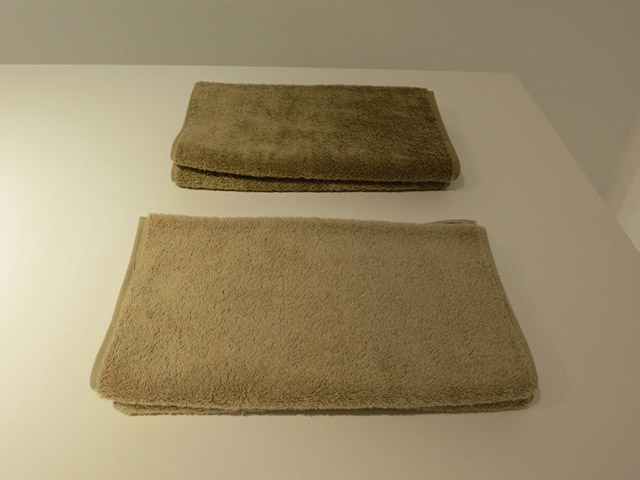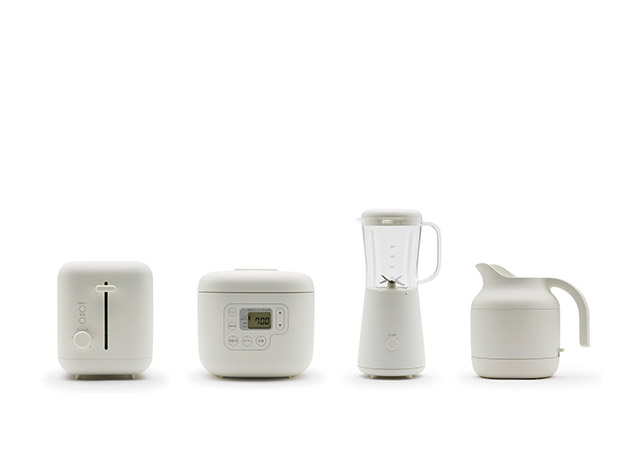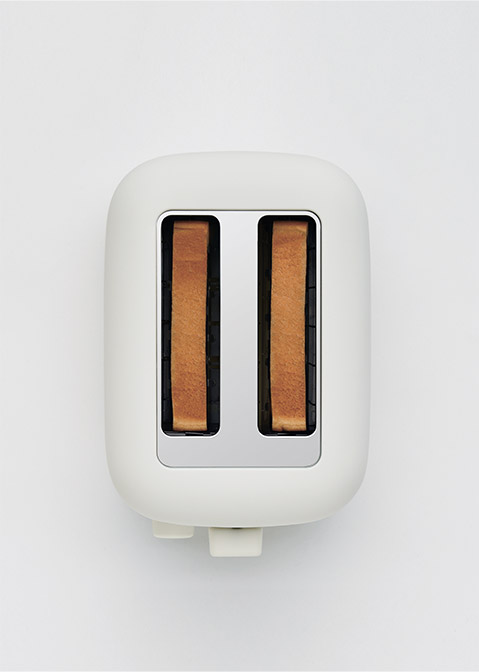Naoto FukasawaMicro Consideration
I am involved in product development and design at MUJI. Today, I want to share with you the concept of “micro consideration,” which describes the level of detail with which all MUJI products take into consideration people’s lifestyles.

“MUJI is enough” is the key phrase we use to encapsulate this very concept. In essence this means, “MUJI is satisfying enough.” For example, you might be out shopping for something you have an image of in your mind, walking from store to store, but never finding the thing you are looking for. Finally, you go to MUJI, and there it is, the precise thing you had imagined. It is that moment when you think to yourself, “This is it. This will do.”I’m often asked exactly what kind of company MUJI is. Even the people who work at MUJI had never put together all the information necessary to really answer the question of what MUJI actually is. I’d like to show you now a video we put together to show that MUJI people and all of you feel that “MUJI is actually a pretty great company and a pretty great brand.” I think it’s obvious from this how much micro consideration is given to the fine details of every aspect of people’s everyday lives.

The first thing I designed for MUJI was this CD player. Everything in our lives is integrated. In other words, unified. It’s not just a thing. You pull the string and the music flows out as air flows. It’s the entire physical sensation. From the perspective of MUJI fulfilling the consideration aspect of this experience, I think this CD player expresses this thought in a straightforward way.
“Without Thought” is a phrase that I like to use. For example, trying to get an umbrella to stand up without an umbrella stand by using the grooves in a tile floor is something that people do. Therefore, MUJI doesn’t think of making an umbrella stand, but instead thinks that perhaps creating a simple groove might be a good place to start. This is the kind of living MUJI tries to imagine. MUJI starts by thinking of things that we do naturally and without thought, always thinking about what is most appropriate for day-to-day living.
Oftentimes, people regret buying too much or eating too much. Therefore, MUJI achieves the ultimate level of comfort in what is “Just Right.” Essentially, “Just Right” equates to the happiness people feel when something is “Just Right.” In the same way, since the opening of this flagship store, I think the happiness you seem to experience when you visit tells us that this must be “Just Right.” I encourage you to look for the things in your life that are “Just Right.”This is how MUJI thinks of all of its products, such as the mattress with legs, rather than a bed, or a shelf with a minimum amount of structure, and polypropylene boxes that make organization easy. MUJI is continuously counter balancing its position against society in order to give harmonies to people’s lives.
I think the making of a product is about drawing a line within a space. It is the line in the center that remains balanced no matter how much pressure is applied from either side.
All of us at MUJI are united in drawing this one harmonious line. Of course, finding the size that is “Just Right,” and for example, a thickness for table legs and tabletops that is “Just Right,” is what we are constantly considering.

In terms of processing and materials, MUJI chooses the easiest processing methods and the materials that are “Just Right.”This is a business card case. Using the simplest methods possible to make products — this is the MUJI principle. As a result, MUJI offers a very compact lifestyle without things being too big.Let’s take a look at the complete modules and the lifestyle that comes from our ideas about this kind of compact living, or what we call “Compact Life.”
In the project, we have standardized basic dimensions of storage products, which were initially varied, based on our module design concept. In addition, thinking about the “Compact Life” concept in terms of travel, we have made things even more succinct and compact, and created MUJI to GO. In the project, you can see the very minute level of detail with so much micro consideration.
When I look at this in its entirety, I am amazed at how carefully everyone involved thought this through. Even though, I too, was involved in the creation of these products, I did not have the opportunity to look at the whole, so it still surprises me a bit to realize the abundance of micro consideration when all of these are brought together.

Lately, one of my favorite things is this hanger that you can travel with. The attention to detail that went into making this hanger so that you can travel with it is quite amazing to me. Naturally, traveling, which is the act of taking yourself away from your daily life to a place where many services are provided and you do a variety of things, is very attractive. But, wouldn’t it be great to bring some of your daily life with you, like washing your socks and undergarments there in front of a beautiful ocean or mountain view. This is the idea that MUJI is proposing with these products.

How happy you are in your daily life is what is most important to MUJI.This hard shell suitcase is the smallest size, the minimum size for living. The concept is that all of the happiness of your daily life is contained within this suitcase. I believe that the peace people find in daily life comes from the repetition of daily routines, which brings about a steady mind. Clean up after use. Wash when things get dirty. Throw away when you accumulate too much. Don’t buy if you aren’t sure. I think this kind of repetition helps maintain a very calm spirit. I believe every product in its own way expresses the richness of having the bare minimum.
I am often asked, “Exactly what is it that’s so good about MUJI?” and “What value is there in MUJI?”
These are quite difficult questions. But, if I respond by asking, “What if MUJI didn’t exist?” we can better understand its value. For example, what if you moved and there wasn’t a MUJI nearby? You wouldn’t know what to do. But, because MUJI exists, you can go there first and gather the most basic items necessary for your life. This, I feel, very much exemplifies the value of MUJI.
MUJI products are always thought of from the perspective of not what can be added, but what can be subtracted. These are some of our latest light fixture designs. Their silhouettes are quite ordinary, but very beautiful. Our clocks also look like something you might see anywhere, but clocks like these are actually quite hard to find. MUJI believes that people deserve the leading role in life, not things. MUJI aims to provide the background, to play a supporting role to you, the leading actor.Material is the other major part of what defines MUJI. The organic cotton we use in our clothes comes from cotton fields where we oversee its growth all the way to product creation.
The Japanese word “manma,” which means “as-is,” has been used for a long time. Materials, as they are. Natural flavors, no flavors added. Based on this concept of natural appearances, with no dressing up, product development begins with the materials. Linen is one of these. There are some products in which wool from animals is also used as-is, without any added colors.Material coloring is another point of definition. MUJI uses natural dyes that are made of plant parts that are usually thrown away. Rose stems, for example.

This was taken from a coconut shell. MUJI also makes furniture, so we use wood waste from furniture production for dyeing, as well. All of these are used to achieve the color of MUJI materials.
While MUJI makes a variety of items for the general consumer, one of its latest projects completed was for Narita International Airport, which serves the greater Tokyo area. We designed all of the furniture for the low-cost carrier terminal at the airport. The philosophy of the MUJI brand is proven by the way it manages to bring life to every manner of place.
In this low-cost carrier terminal, people often stay overnight or arrive very early in the morning. This means the seats are not used just for sitting, but also for lying down. MUJI therefore used its mattress with legs idea to create a new place to relax, which was the basic concept. Even though we accomplished this at a very low cost, many people have said they like these designs more than the fixtures in the main terminal.

I also designed MUJI kitchen appliances. We could, for example, conceptualize it like this: on the far left is the wall and on the far right is a person. The far left wall is squared and the objects gradually get rounder as they get closer to the person. This is the general idea. Products are categorized based on this scale that we’ve plotted. Based on this definition, we are able to make decisions about the overall shape of the products, such as how square or round each should be. So, while the refrigerator is squared due to it being closest to the wall, these parts of the microwave are slightly softer. MUJI designs the overall shape while taking into consideration the inevitability of such form. This is important.

The lid of this rice cooker has this part that protrudes a little bit on top. This is also micro consideration, and MUJI is the only one that has done it. This is a characteristically MUJI design feature and is not something you will find with other appliance brands. This detail becomes a point of communication with people that like MUJI. MUJI’s practices and products have become ingrained in the actions of our daily lives.

This is not merely a round toaster; its shape offsets the right angles of the toast itself. Again, its soft shape is not the end story. Its shape is rounded because it’s the part that comes closest to its users. Because the electric kettle is the object closet to people, it has the softest shape.
Industries have always been categorized as, for example, appliances or daily goods. At MUJI, however, there are no categories. Therefore, we design based on the idea that home appliances will be intermingled with daily goods.
Another recent and very interesting project that MUJI worked on is called MUJI HUT, which is a small prefab house. It is not meant as a place to be lived in all the time, but rather as an affordable house that could be built on a small site. You could stay there for short periods and it offers a minimalist life.

The designers Jasper Morrison, Konstantin Grcic, and I each designed our own version of the hut. The nice thing about a small house like this is that it’s ok to omit all that is unnecessary. I think this is enough to provide a nice enjoyable weekend away.
Lastly, I will introduce our Found MUJI activities.
This is not about making things, but rather about searching for things in various regions that are very much in line with MUJI’s aesthetic. We started in Beijing.

These gray bricks are very MUJI-esque in color, I think. At the antique market we found this dish that was made during the Song Dynasty. I have a feeling that this is probably not a real antique, but I hear these are still being made today in Jingdezhen. So we knew that we could make this kind of product using the same techniques, clay, and kilns as they used in the Song Dynasty. It made us believe MUJI could try to produce this. There are many things in our daily lives that we’re accustomed to seeing, but when we look at them through a MUJI filter, we realize how great some of these things really are. We realize that they might be familiar to us. Even the stacked pails we found at a household supplies shop were quite beautiful when looked at individually.

I also found these workers’ gloves that I quite like. I don’t mean that we are selling all of these things at MUJI, but in this way, we are able to try to further define what MUJI is by travelling to different parts of the world to search for such items. This is another one of MUJI’s undertakings. We did actually create a store in Tokyo called Found MUJI with the many things that we found and collected in our travels.

These are jars from a drug store. This was difficult because, although we asked to take one, we were told we couldn’t. However, after one of our MUJI staff properly bargained for it, we were able to acquire one, after all. Some of these items may go on to become regular products at MUJI. Most recently, we held a Found MUJI furniture exhibition in China. The exhibition was held in Shanghai, and many people were moved by the way the items were so beautifully displayed, although they were things that you’re already accustomed to seeing in your daily life. From this, MUJI created a line of furniture called Ming.
It pleases me to have been able to share with you today the concept of micro consideration that is behind the designs that mean “MUJI is enough” and “MUJI is just right.”
<
>